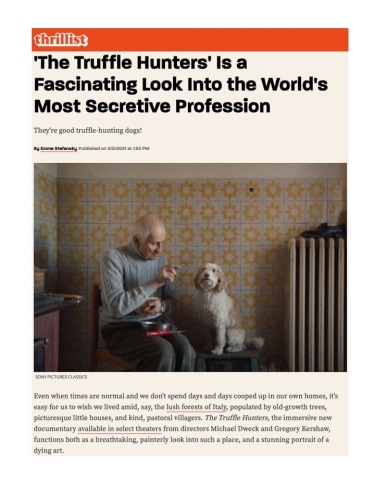'The Truffle Hunters' Is a Fascinating Look Into the World's Most Secretive Profession
Thrillist
03/05/2021
Back
They're good truffle-hunting dogs!
By Emma Stefansky
Even when times are normal and we don't spend days and days cooped up in our own homes, it's easy for us to wish we lived amid, say, the lush forests of Italy, populated by old-growth trees, picturesque little houses, and kind, pastoral villagers. The Truffle Hunters, the immersive new documentary available in select theaters from directors Michael Dweck and Gregory Kershaw, functions both as a breathtaking, painterly look into such a place, and a stunning portrait of a dying art.
The stars of The Truffle Hunters can be separated into three categories: the humans, the dogs, and the truffles themselves. The truffles, fruiting bodies of a subterranean type of fungus, are tough to find under the best of circumstances, and the specific kind of truffle featured in the movie is the Alba white truffle, increasingly rare and always in high demand. At first glance, you wouldn't think a movie like this would be as ambitious an undertaking as a superhero blockbuster or a Borat movie, but in order to film their documentary, Dweck and Kershaw had to work to earn the trust of the men who dig up these small, sort of ugly, staggeringly expensive fungi.
The world of truffle hunting is insular and by nature competitive and full of suspicion, foragers constantly battling over territory in confrontations that can sometimes turn violent. Less-honest hunters will forage in secret on land that's not theirs, stealing the income from the more established old guard, and respected buyers will deal under the table, taking any opportunity they can find to turn a larger profit. The little mushrooms sell for hundreds, even thousands of dollars, and yet those who make a living finding them live in tiny towns, in simple houses, caring for their few friends in the business, their families, and their dogs.
Oh, the dogs! There is no "breed" of truffle dog, only dogs that fit certain requirements: smart enough to be trained, a desire to work, and a powerful and selective sense of smell. However they did it, truffles evolved to smell tasty, even from a foot underneath the earth, signaling to the animals savvy enough to find them that they are delicious to eat, spreading their spores to other spots on the ground every time they're dug up. The documentary follows a few different dogs, owned by a few different elderly truffle hunting experts, showcasing, in a storybook manner, the complex and loving relationship between the two.
Most of The Truffle Hunters is spent tramping through the woods, climbing over mossy deadfalls and through briar patches as the dogs, sometimes lanky, sometimes small, always delightfully fluffy, sprint on ahead, following webs of scent trails our meager human noses couldn't hope to pick up. At times, we meet back up with them in their homes, where one man shares conversations at the breakfast table with his beloved Birba, while another sneaks out of the house to forage at night despite his wife's protestations, cradling little spotted Titina. The dogs are by turns pets, family members, and coworkers. (Call Me By Your Name and Suspiria director Luca Guadagnino, owner of a truffle dog, is an executive producer.)
Apart from all of this, the film is simply beautiful to look at, with lengthy, leisurely takes of a single portion or forest or spot on a hill, watching and waiting for a man and his truffle dog to walk past. The directors used the landscapes and lighting of Italian master painters as inspiration, waiting hours for just the right angle of sunlight just to get one simple shot. Other portions of the movie are enhanced with thrilling, dizzying "dog-vision" scenes, for which they attached small cameras to the dogs before they were set loose, filming light-speed rushes through the underbrush that smear rich greens and browns and gold across the screen. It's a beautiful movie, but it also feels like a love poem to something the world is in danger of losing, the fires and clangs of industry and capitalism having no place in the small yet teeming world of this mysterious profession. Like its namesake little fungus, a movie like this is a rare, valuable treat.